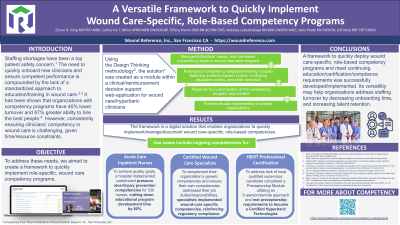Practice Innovations
(PI-022) A Versatile Framework to Quickly Implement Wound Care-Specific, Role-Based Competency Programs

Introduction Methods Using the Design Thinking methodology5, the framework* was created leveraging a versatile, wound care-specific learning management module within a clinical/reimbursement decision support web-application**: ● Managers/clinicians’ needs, and role-based competency areas were mapped ● Role-based competency templates/training modules featuring evidence-based content, continuing education credits, and skills were built ● Playbook for customization of the competency program was created Results Use cases include: ● Ongoing competencies for acute care nurses: to achieve quality goals, a hospital implemented customized pressure ulcer/injury prevention competencies for 330 nurses, cutting down educational program development time by 80%. ● Ongoing competencies for certified wound care specialists: to complement their organization’s generic competencies and ensure their own competencies addressed their job duties/responsibilities, specialists implemented wound-care specific competencies, reinforcing regulatory/accreditation compliance. ● Preceptorship for professional certification: to address lack of local qualified supervisor, candidate completed a Preceptorship Module utilizing an in-person/remote approach and met preceptorship requirements to become a Certified Hyperbaric Technologist. Discussion/Conclusion A framework to quickly deploy wound care-specific, role-based competency programs and meet continuing education/certification/compliance requirements was successfully developed/implemented. Its versatility may help organizations address staffing turnover by decreasing onboarding time and increasing talent retention.
Staffing shortages have been a top patient safety concern.1 The need to quickly onboard new clinicians and ensure competent performance is compounded by the lack of a standardized approach to education/training in wound care.2,3 It has been shown that organizations with competency programs have 40% lower turnover and 87% greater ability to hire the best people.4 However, consistently ensuring clinicians’ competency in wound care is challenging, given time/resource constraints. To address these needs, we aimed to create a framework to quickly implement role-specific, wound care competency programs.
Methods:
Results:
The framework is a digital solution that enables organizations to quickly implement/manage/document wound care-specific, role-based competencies.
Discussion:
Trademarked Items: Trademarked Items
* Competency Tool, Wound Reference, Inc., San Francisco, CA
** WoundReference Clinical Decision Support Web-App, Wound Reference, Inc., San Francisco, CA
References: References
1. ECRI. ECRI Reports Staffing Shortages and Clinician Mental Health are Top Threats to Patient Safety [Internet]. ECRI. 2022 [cited 2023 Jan 7]. Available from: https://www.ecri.org/press/ecri-reports-staffing-shortages-and-clinician-mental-health-are-top-threats
2. Williams EM, Deering S. Achieving competency in wound care: an innovative training module using the long-term care setting. Int Wound J. 2016 Oct;13(5):829–32.
3. Corriveau G, Couturier Y, Camden C. Developing competencies of nurses in wound care: the impact of a new service delivery model including teleassistance. J Contin Educ Nurs. 2020 Dec 1;51(12):547–55.
4. Garr S. Integrated Talent Management: A Roadmap for Success. Research Bulletin. 2012 Oct 19;
5. Ferreira FK, Song EH, Gomes H, Garcia EB, Ferreira LM. New mindset in scientific method in the health field: Design Thinking. Clinics. 2015 Dec 10;70(12):770–2.
6. Mize J, Hamm T. Quality of Care Requires Ongoing Competency Evaluations [Internet]. Woundreference.com. 2021 [cited 2021 Jun 14]. Available from: https://woundreference.com/blog?id=competency-assessments
7. The Joint Commission. About Our Standards | The Joint Commission [Internet]. 2021 [cited 2021 Jul 15]. Available from: https://www.jointcommission.org/standards/about-our-standards/

.png)